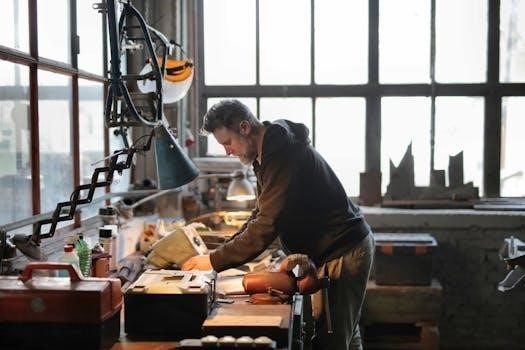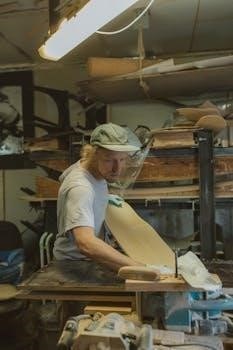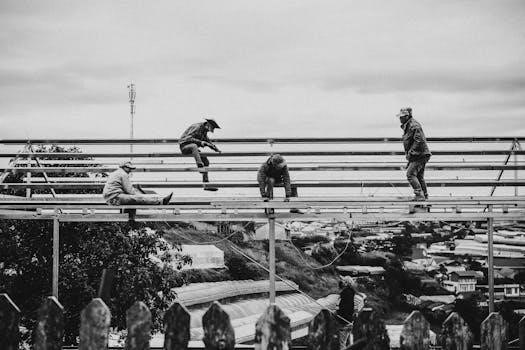
male vs manual
The realm of manual labor, involving physical work done by humans, has historically been associated with men, often due to perceived differences in strength and physical capabilities. This association has influenced gender roles in the workplace, with men frequently dominating sectors requiring physical exertion, like construction and manufacturing.
Defining Manual Labor
Manual labor, at its core, involves physical work performed by humans, distinguishing it from tasks executed by machines or animals. This type of labor is characterized by its reliance on bodily strength and physical exertion to complete tasks. The term “manual,” originating from the Latin word for hand, often implies work primarily done with one’s hands, though it encompasses broader physical activities. Manual labor spans a wide range of occupations, from construction and agriculture to manufacturing and various trades. These jobs typically demand physical strength, endurance, and sometimes repetitive movements. The nature of manual labor can vary significantly, from heavy lifting and material handling to more delicate tasks requiring fine motor skills. It represents a fundamental type of work that has shaped societies and economies throughout history. Understanding manual labor requires recognizing its physical demands and its role in various industries and economic activities, differing markedly from intellectual or sedentary work.
Traditional Gender Roles in Manual Work
Historically, manual labor has been heavily associated with traditional gender roles, particularly the idea that men are better suited for physically demanding jobs. This belief stems from perceived differences in physical strength and endurance, leading to a societal expectation that men should perform the majority of manual labor tasks. Consequently, many industries involving heavy lifting, construction, and manufacturing have been predominantly male domains. This division of labor has been reinforced through cultural norms and expectations, often relegating women to less physically demanding roles, or “pink collar” jobs, such as secretarial work or retail. The traditional view also suggested that women were more suited for tasks requiring less strength and more dexterity, further entrenching the gendered division in the workforce. This historical pattern has led to a significant gender imbalance in many manual labor sectors, reflecting deep-seated societal beliefs about men’s and women’s roles and capabilities in the workplace. The Industrial Revolution further solidified these gender roles, with factories often employing men for heavy machinery operation.
Physical Differences and Manual Work
Physical attributes often play a role in manual labor, with men generally having greater muscle mass and strength. This has led to certain physical tasks being associated more with men, impacting occupational distributions and potential injury risks.

Strength and Physical Capacity
Traditional views often link men with greater physical strength and capacity, which are perceived as beneficial in manual labor roles. The assumption is that men’s generally larger size and muscle mass make them naturally suited for tasks involving heavy lifting, construction, and other physically demanding jobs. This perception has deep roots in societal norms, leading to the concentration of men in occupations requiring substantial physical exertion. However, it is crucial to recognize that individual variations in strength exist within both genders. While men might have a statistical advantage in average physical capacity, not all men are equally strong, and many women possess considerable physical capabilities. Furthermore, the correlation between strength and job performance in many manual labor fields is not always direct, with factors like technique, endurance, and teamwork also playing crucial roles. Focusing solely on strength as a determinant of suitability for manual work can perpetuate gender-based stereotypes and limit opportunities for qualified individuals of all genders.
Occupational Injury Disparities
Occupational injury disparities reveal a complex picture regarding gender in manual labor. While it might be assumed that men, often employed in more physically strenuous roles, experience a higher incidence of injuries, research suggests a more nuanced reality. Studies indicate that women in some manual labor sectors may face a greater risk of certain types of injuries, potentially due to factors like differences in body mechanics, work practices, or even equipment design that is not ideally suited for their physical attributes. The types of injuries also vary between genders, with men potentially experiencing more trauma from heavy lifting and equipment operation, while women might encounter more repetitive strain injuries or issues related to awkward postures. These disparities may also be influenced by the fact that women are sometimes relegated to tasks deemed less physically demanding but still carry a high injury risk. Understanding these discrepancies is crucial for developing targeted safety interventions and ensuring a more equitable and safer working environment for all individuals involved in manual labor.
Impact of Physical Labor on Health
The impact of physical labor on health presents a multifaceted picture, with both potential benefits and risks. On one hand, regular physical activity inherent in manual labor can contribute to cardiovascular health, muscle strength, and overall fitness. However, the demands of this type of work can also take a significant toll on the body. Prolonged exposure to heavy lifting, repetitive movements, and awkward postures can lead to musculoskeletal issues, including back pain, joint problems, and carpal tunnel syndrome. Furthermore, men in physically demanding jobs have been shown to have a higher risk of premature mortality compared to those in more sedentary roles. This may be attributable to the strain on the body and exposure to hazards such as noise and vibrations. Additionally, while some studies suggest that manual labor might have a positive impact on male fertility, these benefits must be weighed against the potential long-term health consequences of physically demanding jobs. A balanced approach, focusing on safety measures, and ensuring proper ergonomic practices, are vital for mitigating the negative health impacts of physical labor.

Socioeconomic Factors and Gender in Manual Labor
Socioeconomic factors significantly influence gender roles in manual labor, with gender segregation persisting in the workplace. Pay gaps and limited opportunities further affect women in these roles, reflecting broader societal inequalities. The Industrial Revolution’s impact also shaped these dynamics.
Gender Segregation in the Workplace
Gender segregation in the workplace is a persistent issue, particularly within manual labor sectors. Traditionally, men have been over-represented in physically demanding occupations such as construction, mechanics, and manufacturing, often involving tasks with heavy lifting or repetitive movements. Conversely, women are often concentrated in roles considered “pink-collar” jobs like social work, retail, and service industries, which are often lower-paying. This division stems from historical perceptions of physical capabilities and gender roles, where men are presumed better suited for strenuous work. This segregation limits opportunities for both genders, reinforcing stereotypes and creating disparities in pay and career advancement. The persistence of these patterns can be seen in data showing that skilled manual labor positions remain predominantly male, highlighting the ongoing challenges in achieving gender balance in the workplace. Despite progress, these deeply entrenched norms continue to shape occupational distributions, necessitating efforts to promote inclusivity and break down traditional barriers.
Pay and Opportunity Gaps
Significant pay and opportunity gaps persist in manual labor, often exacerbated by gender. Men, historically dominating these sectors, frequently command higher wages in traditionally male-dominated roles like construction and manufacturing. Women, when present in these fields, often face lower pay for comparable work, demonstrating a persistent wage disparity. This pay gap is compounded by limited opportunities for women to advance into leadership or specialized roles within manual trades, restricting their career growth. The concentration of women in lower-paying “pink-collar” jobs further widens the overall economic disparity. This inequity is not solely about pay; it extends to access to training, mentorship, and promotion. These gaps are often rooted in historical biases and the perpetuation of gendered occupational roles. Addressing these issues requires dismantling systemic barriers, advocating for equal pay, and creating pathways for women to access and thrive in all aspects of the manual labor landscape, thus fostering a more equitable work environment for all.
The Industrial Revolution’s Impact
The Industrial Revolution significantly reshaped the landscape of manual labor, amplifying pre-existing gendered divisions. The shift towards factory-based production created a clear distinction between manual and non-manual work, often solidifying men’s dominance in the former. Large-scale industrial production demanded physical strength, further emphasizing men’s perceived suitability for these roles. This period solidified gender segregation in the workplace, with women often relegated to lower-paying, less physically demanding jobs, while men were more likely to be employed in the factories and heavy industries. This divide reinforced societal norms that linked masculinity with physical labor and further marginalized women’s economic opportunities. The changes wrought by the Industrial Revolution had a long-lasting impact on how manual labor was perceived and how it became associated with men, a legacy that continues to influence modern labor markets. The era also established the framework for pay and opportunity gaps that still affect women in manual labor today.
Modern Perspectives on Male and Manual Labor
Modern perspectives on manual labor are evolving, acknowledging technological advancements and shifting gender roles. While men still dominate many manual trades, changing perceptions are slowly influencing the landscape, with a growing recognition of women’s capabilities in these fields.
Technological Advances in Manual Work
The integration of technology is significantly reshaping the landscape of manual labor, impacting both the physical demands and the skills required. Automation, robotics, and advanced machinery are increasingly being deployed in various industries, from construction to manufacturing, reducing the need for brute strength and repetitive tasks. These technological shifts are leading to a redefinition of what constitutes manual work, often requiring workers to possess technical proficiency alongside physical stamina. The introduction of power tools and ergonomic equipment has also mitigated some of the physical risks associated with manual labor, making these jobs potentially more accessible to a wider range of individuals, regardless of gender. Furthermore, the use of digital tools for planning, design, and project management has added a cognitive layer to many manual labor roles, requiring a blend of physical and intellectual capabilities. This evolution is prompting a re-evaluation of traditional gender roles within these industries, as the emphasis moves from sheer physical power to a more balanced skill set.
Changing Perceptions and Gender Roles
Traditional perceptions of manual labor as solely a male domain are gradually shifting, driven by societal changes and technological advancements. The notion that physical strength is the primary determinant of suitability for manual work is being challenged, as technology reduces the need for sheer physical force. This shift is opening doors for more women to enter traditionally male-dominated fields. Simultaneously, evolving societal attitudes are beginning to recognize the diverse skills needed for manual labor, including problem-solving, technical know-how, and attention to detail, not solely brute strength. These changing perceptions are encouraging a more inclusive approach, with an emphasis on ability rather than gender stereotypes. Furthermore, as more women enter these sectors, they contribute to a transformation of the work culture, promoting a more balanced and equitable environment. The gradual breakdown of these rigid gender roles is creating opportunities for both men and women to explore manual labor careers based on individual aptitude rather than societal expectations, fostering a more diverse and dynamic workforce.

The Future of Men in Manual Labor
The future of men in manual labor is undergoing a transformation, influenced by technological advancements and shifting societal expectations. While traditional manual labor jobs may decline, new opportunities are emerging, requiring adaptability and specialized skills. Men will likely need to embrace technology, learning to operate and maintain automated systems. The focus will shift from brute strength to technical expertise, problem-solving, and data analysis. This doesn’t mean the disappearance of physical work, but a redefinition of it, with a greater emphasis on precision and efficiency. Moreover, as the perception of manual labor diversifies, men may find themselves working in more collaborative and inclusive environments, alongside women who are increasingly entering these fields. This shift will challenge outdated stereotypes, forcing a reevaluation of what it means to perform manual labor. Men who can adapt to these changes, acquiring new skills and embracing a more collaborative approach, will be well-positioned to thrive in the evolving landscape of manual work. The future for men in these roles is not about physical dominance, but rather about adaptability and proficiency.

Leave a Reply
You must be logged in to post a comment.